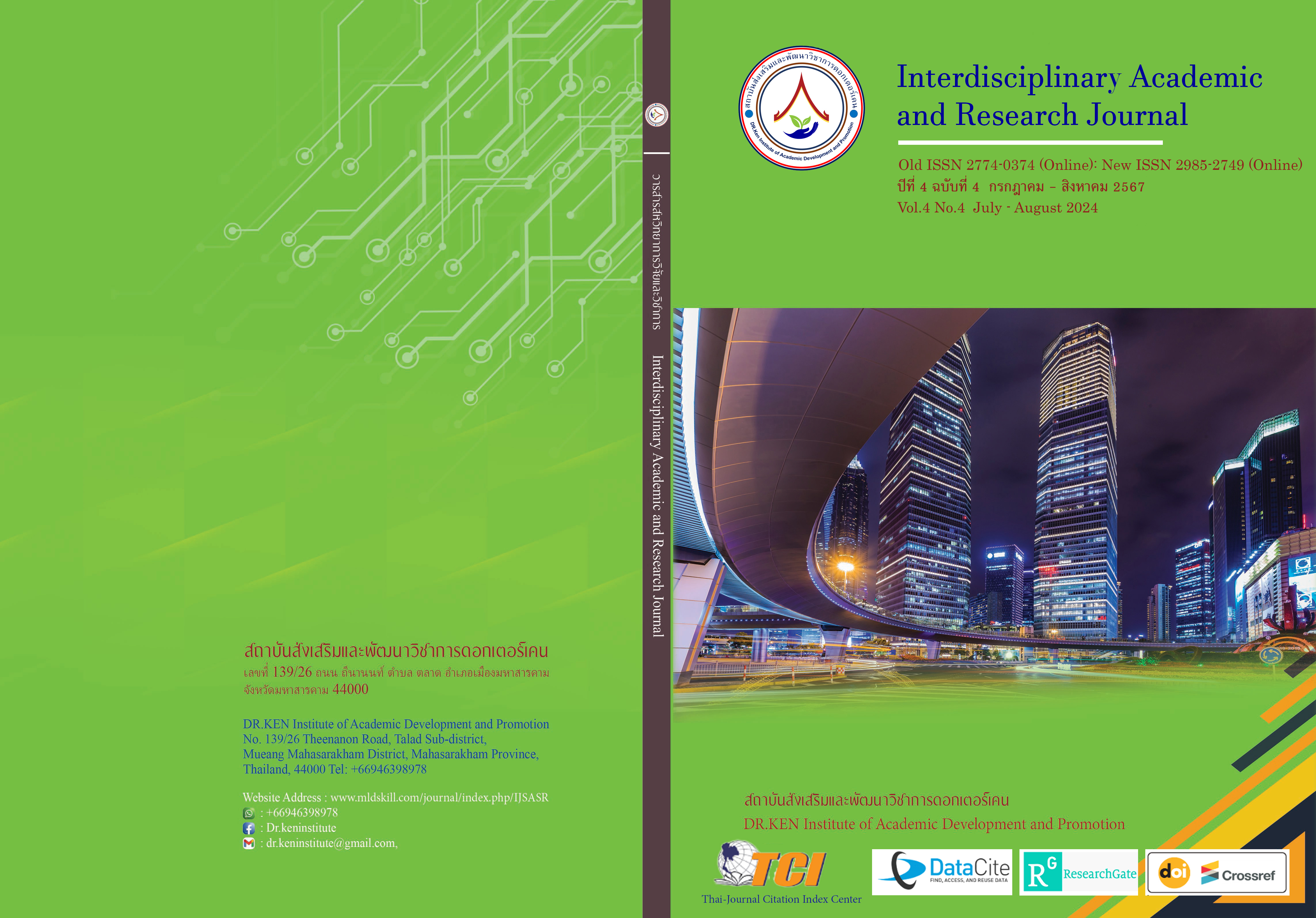Development of Knowledge Management Guidelines for Educational Institutions Under The Office of Nakhon Ratchasima Secondary Education Service Area
DOI:
https://doi.org/10.60027/iarj.2024.276760Keywords:
Knowledge Management; , Developing Guidelines; , Deming CycleAbstract
Background and Aims: One of the resources for producing valuable and distinctive work is knowledge. The more you use knowledge, the more valuable it becomes because knowledge has no limits. More new things can be learned and more useful knowledge can be applied by the staff members of the educational institution who possess greater knowledge. Therefore, this research aims to (1) study the current conditions, desired conditions, and necessary needs for knowledge management of educational institutions under the Nakhon Ratchasima Secondary Educational Service Area Office. (2) To develop guidelines for knowledge management of educational institutions under the Nakhon Ratchasima Secondary Educational Service Area Office.
Methodology: There are 2 phases of this research, phase 1, is to study current conditions, desirable conditions, and the need for Knowledge Management of schools under the Nakhon Ratchasima Secondary Educational Service Area Office. The study samples were groups of 92 school’ administrators and 249 teachers obtained by opening the Krejcie and Morgan (1970)chart and then using the stratified random sampling method. Each school is divided by size. Then, use the Simple Random Sampling method to find out the number of the study samples and get 341 of them. The research covered the questionnaire form as the tool and analyzed it by using basic statistics. Phase 2, is to develop guidelines for knowledge management of schools under the Nakhon Ratchasima Secondary Educational Service Area Office. The specific sample groups were 4 school administrators and teachers, 5 experts, and 5 senior experts interviewing and analyzing by the data analysis method.
Results: (1) The current conditions for knowledge management of schools under Nakhorn Rathasima Secondary Educational Service Area Office were at the average level, the overall desirable conditions were at the highest level, and ran the k of needs from the highest to the lowest were as follows, sharing knowledge, bringing the knowledge to the practice, creating and seeking knowledge, processing and screening the knowledge, the indicating of knowledge and the systematics of knowledge management. (2) Knowledge management guideline of the school under Nakhorn Rathasima Secondary Educational Service Area Office using the Deming cycle (PDCA) implemented in 6 steps, 30 guidelines as follows, 5 guidelines of knowledge identification procedures, 5 guidelines for creating and seeking knowledge, 5 guidelines of systemizing knowledge management, 5 guidelines of sharing knowledge, 5 guidelines of processing and screening the knowledge, 5 guidelines of bringing the knowledge to the practice. The 6 steps follow the Deming cycle (PDCA) processes as follows, (P) Plan is the cooperative planning of the school’s administrators and the teachers for knowledge management. (D) Do is the implementation of knowledge management of the school through various methods. (C) Check is the schools’ administrators monitor and check the results of the performance of all teachers. (A) The Act is monitoring and collecting information that reflects the results to all the interested people. The overall suitability assessment and the overall feasibility assessment were at a high level.
Conclusion: The Nakhorn Rathasima Secondary Educational Service Area Office's knowledge management status was found to be average, but ideal conditions were primarily ranked at the highest level, highlighting the need to improve knowledge creation, application, sharing, and systematization. Furthermore, a knowledge management guideline that was implemented in six strategic steps using the Deming cycle (PDCA) demonstrated a high degree of suitability and feasibility, highlighting the guideline's potential efficacy in enhancing knowledge management practices in the context of education.
References
กระทรวงศึกษาธิการ. (2546 ก). การบริหารสถานศึกษาขั้นพื้นฐานที่เป็นนิติบุคคล. กรุงเทพฯ: กระทรวงศึกษาธิการ.
ฉลาด จันทรสมบัติ. (2550). การพัฒนาคนของประเทศไทยปี 2550: เศรษฐกิจพอเพียงกับการพัฒนา คน. Journal of Administration and Development, Mahasarakham University, 1(1), 114-127.
เฉลิมชัย วรรณสาร. (2556). การพัฒนาครูโดยใช้กระบวนการจัดการความรู้ในโรงเรียนประถมศึกษาสังกัดสํานักงานเขตพื้นที่การศึกษาประถมศึกษาเชียงราย เขต 1. วิทยานิพนธ์ครุศาสตรมหาบัณฑิต: มหาวิทยาลัยราชภัฏเชียงราย.
ณวัฒน์ พระงาม. (2559). การพัฒนากลยุทธ์การจัดการความร้ำหรับสถาบันอุดมศึกษาเอกชน. วารสารวิชาการอุตสาหกรรมศึกษา, 10(2), 85 – 94.
ธีระ รุญเจริญ. (2550). ความเป็นมืออาชีพในการจัดและบริหารการศึกษายุคปฏิรูปการศึกษา. กรุงเทพฯ: ข้าวฟ่าง.
ธีระวัฒน์ เยี่ยมแสง. (2550). การพัฒนารูปแบบการจัดการความรู้ของสำนักงานเขตพื้นที่การศึกษามหาสารคาม เขต 1. บัณฑิตวิทยาลัย : มหาวิทยาลัยมหาสารคาม
บัณฑิต ฉัตรวิโรจน์. (2550). การพัฒนารูปแบบการจัดการเรียนการสอนแบบการจัดการความรู้ เพื่อเสริมสร้างสมรรถนะการสอนของนักศึกษาครู. วิทยานิพนธ์ครุศาสตรดุษฎีบัณฑิต คณะครุศาสตร์ จุฬาลงกรณ์มหาวิทยาลัย.
บุญชม ศรีสะอาด.(2553). การวิจัยเกี่ยวกับการบริหารการศึกษา. กรุงเทพฯ: สุวีริยาสาส์น.
บุญดี บุญญากิจ และคณะ. (2549). การจัดการความรู้จากทฤษฎีสู่การปฏิบัติ. กรุงเทพฯ: สถาบันเพิ่มผลผลิต แหงชาติบริษัท ซีเอ็ดยูเคชั่น จำกัด (มหาชน).
บุญดี บุญญากิจ. (2548). การจัดการความรู้จากทฤษฎีสู่การปฏิบัติ. พิมพ์ครั้งที่ 3. กรุงเทพฯ: จิรวัฒน์เอ็กซ์เพรส.
ประพนธ์ ผาสุขยืด. (2550). การจัดการความรู้ฉบับมือใหม่หัดขับ. พิมพ์ครั้งที่ 6. กรุงเทพฯ: ใยไหม.
พวงพรรณ แสงนาโก. (2559). การจัดการความรู้ในโรงเรียนขยายโอกาสทางการศึกษาอําเภอเขาสมิงสํานักงานเขตพื้นที่การศึกษาประถมศึกษาตราด.วิทยานิพนธ์การศึกษามหาบัณฑิต: มหาวิทยาลัยบูรพา.
วสันต์ ลาจันทึก. (2548). การจัดการความรู้ในสถานศึกษาขั้นพื้นฐาน สังกัดสำนักงานเขตพื้นที่การศึกษา ขอนแก่น เขต 4. รายงานการศึกษาอิสระศึกษาศาสตรมหาบัณฑิต หาวิทยาลัยขอนแก่น.
วิโรจน์ สารรัตนะ. (2548). นวัตกรรมกับกระบวนทัศน์การศึกษาศตวรรษ ที่ 21. Journal of Yanasangvorn Research Institute Mahamakut Buddhist University, 7(2), 268-283.
วิศรุจ สารจูม. (2563). การพัฒนาแนวทางการจัดการความรู้ของโรงเรียนเอกชน สังกัดสานักงานเขตพื้นที่การศึกษาประถมศึกษาร้อยเอ็ด เขต 3. วิทยานิพนธ์ปริญญาการศึกษามหาบัณฑิตสาขาวิชาการบริหารการศึกษา คณะศึกษาศาสตร์ มหาวิทยาลัยมหาสารคาม.
สำนักงานคณะกรรมการการศึกษาขั้นพื้นฐาน. (2550). แนวทางการกระจายอำนาจการบริหารและการจัดการศึกษาให้คณะกรรมการสำนักงานเขตพื้นที่การศึกษาและสถานศึกษาตามกฎกระทรวงกำหนดหลักเกณฑ์และวิธีการกระจายอำนาจ การบริหารและการจัดการศึกษา พ.ศ. 2550. กรุงเทพฯ: โรงพิมพ์ชุมนุมสหกรณ์การเกษตรแห่งประเทศไทย.
สุชาดา สุรางค์กุล. (2557). แนวทางการจัดการเอกสารจดหมายเหตุในสถาบันอุดมศึกษา: กรณีศึกษมหาวิทยาลัยขอนแก่น. KKU Research Journal (Graduate Studies), 10(3), 145-156. DOI: https://doi.org/10.5481/KKUJGS.2010.10.3.14
สุธรรม ธรรมทัศนานนท์. (2554). การพัฒนารูปแบบการบริหารจัดการตามหลักปรัชญาของเศรษฐกิจพอเพียง สำหรับสถานศึกษาสังกัดสำนักงานเขตพื้นที่การศึกษามัธยมศึกษา เขต 27. วารสารศึกษาศาสตร์ มหาวิทยาลัยบูรพา, 28(1), 140-153.
สุธรรม ธรรมทัศนานนท์. (2556). หลักและทฤษฎีการบริหารการศึกษา. มหาสารคาม: โรงพิมพ์มหาวิทยาลัยมหาสารคาม.
อเนก ไชยโย. (2556). การพัฒนารูปแบบการจัดการความรู้ในโรงเรียนสังกัดสํานักงานเขตพื้นที่การศึกษาประถมศึกษาแม่ฮ่องสอนเขต1. กรุงเทพฯ: มหาวิทยาลัยเวสเทิร์น.
Krejcie, R.V., & Morgan, D.W. (1970). Determining Sample Size for Research Activities. Educational and Psychological Measurement. 30(3), 607 – 610 DOI: https://doi.org/10.1177/001316447003000308
Downloads
Published
How to Cite
Issue
Section
License
Copyright (c) 2024 Interdisciplinary Academic and Research Journal

This work is licensed under a Creative Commons Attribution-NonCommercial-NoDerivatives 4.0 International License.
Copyright on any article in the Interdisciplinary Academic and Research Journal is retained by the author(s) under the under the Creative Commons Attribution-NonCommercial-NoDerivatives 4.0 International License. Permission to use text, content, images, etc. of publication. Any user to read, download, copy, distribute, print, search, or link to the full texts of articles, crawl them for indexing, pass them as data to software, or use them for any other lawful purpose. But do not use it for commercial use or with the intent to benefit any business.
















.png)


